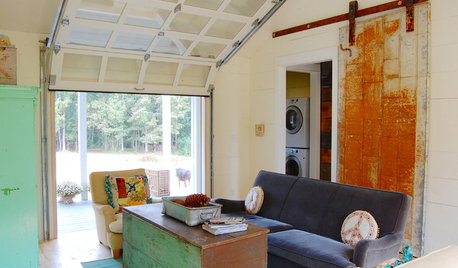need a way to splice large bolts of fabric
Saypoint zone 6 CT
11 years ago
Related Stories

COLORConsider Giving Your House a Big Bolt of Blue
From fresh, vivid turquoise to power-packed cobalt, blue is a great way to lift a neutral color palette
Full Story
HOUZZ TOURSHouzz Tour: A Bolt of British Charm in Brooklyn
A highly decorated New York row house takes its cues from the English countryside
Full Story
DECORATING GUIDESTextile Textbook: Vintage Fabrics Tell a Story
We share a dozen ways to honor the past with heirloom textiles
Full Story
Guest Picks: Fun Fabrics to Perk Up Your Place
Go for striking patterns and rich colors to stir up drama, add a whimsical touch or tie a room together
Full Story
DECORATING STYLES9 Ways to Bring Home a Little British Colonial Style
On a redecorating campaign? Try some tropical accents mixed with dark woods, portable furnishings and a touch of formality
Full Story
KITCHEN DESIGN6 Ways to Rethink the Kitchen Island
When an island would be more hindrance than help, look to these alternative and very stylish kitchen setups
Full Story
DECORATING GUIDES6 Cost-Effective Ways to Go Custom Made
Get a look that’s totally you — and possibly for a lower cost than you might think
Full Story
GARDENING AND LANDSCAPING10 Ideas for Decorating Your Summer Porch
Watch the world go by from a porch decked out with comfy furniture and inspiring accessories
Full Story
DOORSCreative Ways With Barn-Style Doors
Considering jumping on the barn-door bandwagon? These examples in different styles offer inspiration aplenty
Full Story
GARDENING AND LANDSCAPINGBudget Decorator: 10 Ways to Deck Out Your Patio
Hang a vintage sign here and some inexpensive curtains there, for a patio or deck that looks polished and pulled together
Full StoryMore Discussions






jomuir
Saypoint zone 6 CTOriginal Author
Related Professionals
Boston Furniture & Accessories · Chambersburg Furniture & Accessories · Charleston Furniture & Accessories · Evanston Furniture & Accessories · Midland Furniture & Accessories · Eau Claire Furniture & Accessories · Annandale Furniture & Accessories · Sweetwater Interior Designers & Decorators · Annandale Furniture & Accessories · Frisco Furniture & Accessories · Springdale Furniture & Accessories · Adelanto Furniture & Accessories · Sugar Hill Furniture & Accessories · Kendall Furniture & Accessories · Bull Run Specialty Contractorsjomuir